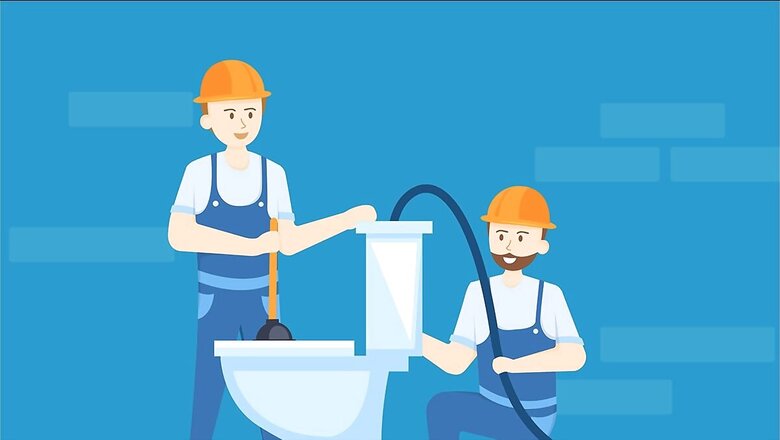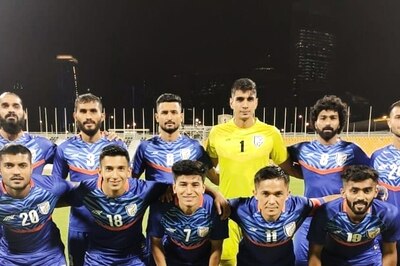
views
In India, you’d be hard pressed to find someone who doesn’t love the smell of petrichor – that wonderful aroma of wet earth we experience at the start of the monsoon. It’s a signal that the scorching hot summer is finally over, and a signal to green growing things, that it’s time to burst forth and grow.
We love the lush greenery that the monsoon brings, the cooler days, the fresher air. For the first few days, we don’t even mind our damp clothing. However, there is a dark side to the monsoon. It’s easy to fall ill – especially with monsoon specific illnesses, or just from catching a cold because of our damp clothing, or from living near (or having to use) a dirty toilet.
Toilets, when done right, enable societies to create better health and immunity, and ward off infectious diseases. However, during the monsoon, keeping toilets (especially public toilets) clean and dry is a huge challenge. A dirty toilet is almost like an invitation to disease – the heavy rainfall and high humidity create an environment that is perfect for the growth of germs, creating potential health hazards.
What Makes Toilets Incubate Diseases During the Monsoon Season
Increased Moisture and Mould Growth:
One of the primary challenges during the monsoon season is the excessive moisture that accumulates in and around toilets. The constant exposure to rainwater and high humidity levels create an ideal breeding ground for mould and mildew. These not only give rise to an unpleasant odour but also pose health risks, such as allergies and respiratory problems. It is also important to check the walls for seepage and water damage – damp walls attract mould, and take much longer to dry out than wet floors.
To overcome this challenge, it is important to ensure proper ventilation in the toilet area. Installing an exhaust fan or keeping windows open during dry spells can help in reducing moisture and preventing mould growth. Additionally, regular cleaning with a disinfectant cleaner like Harpic can help eliminate existing mould and inhibit its further growth.
Waterlogging and Drainage Issues:
Another significant challenge faced during the monsoon season is waterlogging in and around toilets and drains. The excessive rainwater can cause drains to get clogged, leading to stagnant water that attracts mosquitoes and other disease-carrying insects. Waterlogging also hampers the proper functioning of toilets and can create unhygienic conditions.
To address this challenge, regular maintenance of the toilet drains is crucial. Clearing any debris or blockages from the drains before the monsoon season and periodically checking them during the rainy period can ensure smooth water flow and prevent waterlogging. Since this is action that needs to be taken at a municipal level, consider writing to your municipal ward officer in April and May.
Puddles and standing water:
We’re a tropical country, and there are a number of vector borne diseases that are caused by mosquitos. We know that the best defence against these diseases is to control the mosquito population. For that, we need to eliminate puddles and standing water.
Unfortunately, public toilets can become spaces where mosquitoes can proliferate because users of public toilets bring in water on their umbrellas and raincoats, and in their shoes. If the floor doesn’t slope correctly, this results in puddles that stick around all day as the humidity is too high for water to evaporate quickly.
The Best Way to Keep Public Toilets Clean
One of the best solutions to this problem is the appointment of toilet attendants. A toilet attendant is dedicated to the cleanliness and maintenance of the toilet. In addition to being in charge of cleaning the toilet regularly, they are also an essential means of moving the needle on good toilet sanitation – they ensure that the toilet is well supplied with soap, sanitary products and is maintained as needed. Additionally, well trained toilet attendants are able to help differently abled people navigate toilets, as well as create spaces of safety for LGBTQ+ users, who may feel safer with a toilet attendant – especially one who has been through sensitivity training.
If you’re wondering where one can find toilet attendants of this calibre, Harpic has preempted you. The Harpic World Toilet Colleges began in earnest in 2016, with the stated objective of improving the quality of life of manual scavengers through their rehabilitation by linking them with dignified livelihood options. The college operates as a knowledge sharing platform with an aim to uplift the lives of the sanitation workers by educating them about their rights, health hazards, use of technology and alternate livelihood skills. Workers trained by the college are provided placement with various organisations.
Harpic World Toilet Colleges also confer dignity to the work of sanitation workers – no longer are these looked at as unskilled, lowest of the low workers, but as skilled technicians with specialised training. In this way, Harpic World Toilet Colleges kill two birds with one stone: facilitating clean, safe and well-maintained public toilets across the nation, and generating meaningful and respectful employment for sanitation workers.
Other Solutions for Toilet Maintenance:
Regular cleaning aside, there are a number of other considerations that go into a well maintained and well supplied toilet.
Waterproofing and Sealant Maintenance:
Proper waterproofing and maintenance of seals are crucial to prevent water leakage during the monsoon season. Inspection of the toilet area can reveal cracks or gaps where water can seep through and cause damage. When these issues are noticed early, resealing or applying waterproof coatings can ensure integrity of the toilet structure. However, should the leaks and cracks be bigger in size or more structural in nature, it may require professional assistance from a plumber.
Additionally, it is important to regularly check the toilet tank, pipes, and faucets for any leaks. Leaks must be fixed promptly to prevent water wastage and potential water damage. Ensuring a well-maintained and waterproof toilet will not only prevent water-related issues but also contribute to overall cleanliness and hygiene.
Effective Drainage Systems:
To combat waterlogging and drainage issues during the monsoon season, it is essential to have an effective drainage system in place. This includes properly designed and functional toilet drains that facilitate the swift flow of water. Drains must be regularly inspected and cleaned to remove any debris or blockages.
If the area is prone to frequent waterlogging, consider installing a sump pump or drain covers to prevent water accumulation. These measures will help in maintaining a dry and clean toilet environment, minimising the risks associated with stagnant water.
Regular Pest Control
Monsoons often bring along an increase in pests – particularly if you’re on the ground floor. To prevent pests like mosquitoes and flies from breeding in the toilet area, consider implementing pest control measures. Use mosquito nets or screens on windows and doors, and use insect repellents or sprays to keep pests at bay.
The Role of Education and Awareness of Good Hygiene Practices and Toilet Habits
Apart from implementing physical measures, educating and encouraging good hygiene practices among individuals using the toilet is equally important. Promoting the habit of washing hands with soap and water after using the toilet, as well as before meals helps prevent numerous diseases by preventing the spread of germs and maintaining overall cleanliness.
Toilets themselves can serve as a source of education. Using informative posters and signage, particularly that which is obvious to people who cannot read, helps move the needle towards better toilet and hand hygiene, and hence, better health for the entire community.
Luckily, in India, brands like Harpic, which is a leader in the lavatory care segment, have built strong communication strategies around the need for good toilet hygiene habits in particular, and sanitation overall. Harpic decided to take the lead in the sanitation and hygiene movement by creating innovative, thought provoking campaigns and outreach programs.
They partnered with Sesame Workshop India, an educational non-profit working for the early developmental needs of young children, to promote positive sanitation, hygiene knowledge and behaviours among children and families through schools and communities, engaging with 17.5 million children across India. This, in addition to the messaging they already aimed at adults.
Harpic, in addition to creating programming aimed at young children, also pioneered a programme to raise awareness and reinforce healthy toilet and bathroom habits among young children, developing and recognising them as “Swachhta Champions”. These initiatives are a part of the larger umbrella campaign, Harpic Mission Swachhta and Paani, with News18.
Mission Swachhta aur Paani, pioneered by Harpic and News18, is a movement that upholds the cause of inclusive sanitation where everyone has access to clean toilets. It advocates equality for all genders, abilities, castes and classes and strongly believes that clean toilets are a shared responsibility. Clean and safe toilets for all means that our communities are healthier, our children spend more days in school and less days out sick, girls don’t drop out of school, our workplaces are more diverse places, and that our cities and towns are cleaner, safer, and more welcoming.
In order to get the word out, Mission Swachhta aur Paani is creating repositories of information that help you have the right conversations. Whether it is educating your children about toilet etiquette, or learning how you can talk to your local municipal ward officer about getting toilet attendants for public toilets in your locality – Mission Swacchta aur Paani has the information you need to make an impactful argument.
Join us here, to learn how you can contribute to this national conversation, and pave the way to a Swasth Bharat, and a Swachh Bharat.



















Comments
0 comment